
Location: Gilston, QLD
Established: 1997
Architect: Greg Norman & Bob Harrison
First Played: 20th May 2016
Last Played: 20th May 2016
Magazine Ratings

41 (Current)

59 (Current)
With this quest to play Australia’s Top 100 golf courses, there have been three which are the most difficult to obtain tee times. Ellerston (the Packer’s privately owned course), Royal Sydney Golf Club and lastly The Grand Golf Club. Ellerston does not have a club and is invite only, basically the Augusta of Australia in obtaining access. The other two only allow allow guests who are invited by members. The Grand Golf Club is even more exclusive than RSGC, being owned by the members, who are equity shareholders. Corporate days are not allowed and there are no reciprocal clubs.
When I received an email mentioning that an open day was to be held at the club, I was straight on the phone to book my place and organising flights and accommodation. There was no way I was missing this opportunity. An old golf/work colleague, Joe, who lived close to the Gold Coast, was also keen. So this would be another Top 100 course we would play together.

The Grand Golf Club Entrance
Upon arrival at the club, each guest was assigned a member to escort them for the day. We were introduced to the club captain and president over a bite of lunch. It was interesting to hear the story of how the club evolved and their ethos. My only knowledge before hand was watching Ozzie Moore on The Golf Show with his golf tips for playing the game.
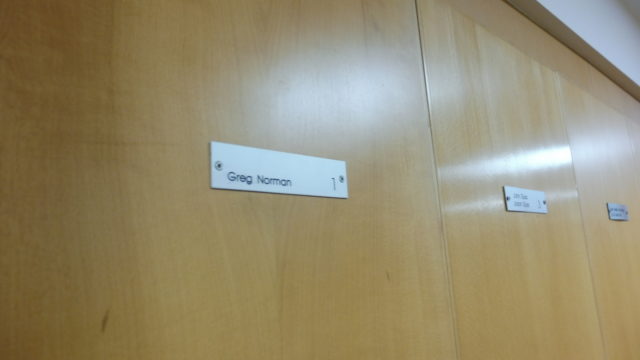

Clubhouse at The Grand Golf Club
The locker room contains a few celebrities as well as the biggest names in Australian golf, including Greg Norman (number one member) and Adam Scott. On the day of our visit, a TV host and current NRL players were also around the course.

Map of The Grand Golf Club
Routing through some undulating terrain and bush land at times, this course was one of the better Norman/Harrison parkland designs I had played. There were some similarities to Brookwater Golf Club, near Brisbane, especially 8 then 10 – 12.


The Grand Golf Club Scorecard
Play for the day was a stableford competition from the white tees. Joe and I were accompanied by club members Ian and Club President Sid.

Hole 1 – 330 meter par 4
The first hole offers asks a question with the initial shot of the round. Having a dogleg to the right, the hole plays over a slight valley before the fairway rises to the green. Bunkers are found down the inside line, so there is the choice to take on more to gain distance, shortening, the second shot, or play safely to the left, but have a longer approach.

No trouble around the 1st green
Playing uphill to reach the green, this is fairly open in its surrounds. First thing was noticing the firmness of the greens in trying to hold the ball, but also the amount of run. They were certainly in good condition. This was a good starting hole, offering a challenge off the tee, but not too punishing around the green.

Hole 2 – 321 meter par 4
A similar length hole followed, however this was predominantly down hill. With a carry required over dense shrubs/trees to reach the fairway, a wide fairway awaits. Bunkers are staggered either side of the fairway.
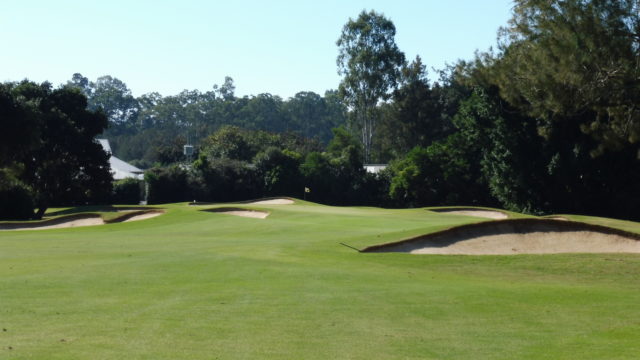
Approach from the 2nd fairway
Some difficulty has been introduced with the green, not only with numerous bunkers around the green, but the putting surface also sloping away from the front. The hole doesn’t look much, but offers a variety of play, especially with the tee shot, but requires a bit of thought to avoid trouble.

Hole 3 – 374 meter par 4
The first real challenging hole, this dog leg right has a fairway which eventually falls away. With land sloping also right to left, potentially bringing the fairway trap into play, it is best to play slightly right.
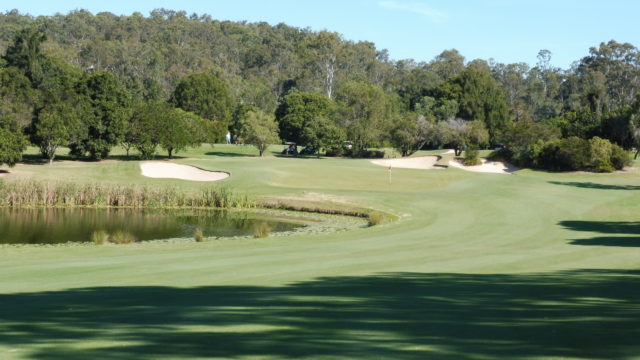
Water in play along the 3rd fairway
Once over the rise the fairway falls away down to the green. I didn’t really take notice to see if long hitters could reach the water down the left, but for most this will need to be carried in some way to reach the putting surface. If not confident there is a layup area to the right. Well designed hole which allows for those out of position, or not long hitters, to skirt the water without finding trouble.

Hole 4 – 360 meter par 4
Playing back in the opposite direction, this hole doglegs to the left. Bunkers are found down either side, but water is left. The fairway is slightly narrower here, but still has plenty of room to play safely.

View from the 4th fairway
Playing to the left here can be hazardous, leaving a carry across water to reach the green. The next thing I noticed was the number of bunkers placed at the rear of the greens. Something not usually found on most courses. With the firmness, I found they are quite often in play. Good hole where par will feel like a true achievement. Offers risk/reward from the tee, but also for the approach.

Hole 5 – 483 meter par 5
Next was the longest hole on the course. The fairway is interesting, angling away but also with a slope on the right side, with a solitary bunker, then a few scattered trees. Not the side to be, although too far left is dense trees, which there is no escape.
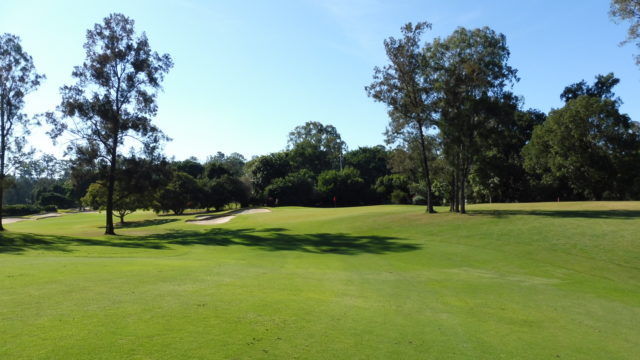
Narrowing 5th fairway
With trees encroaching on the right, you are almost forced to play a certain angle to the green. A small valley is found in front of the putting surface, which also slopes significantly from the rear down to the valley. An interesting hole with the lines of play, but feels a little more restricted in the way it can be played, compared to the previous holes.
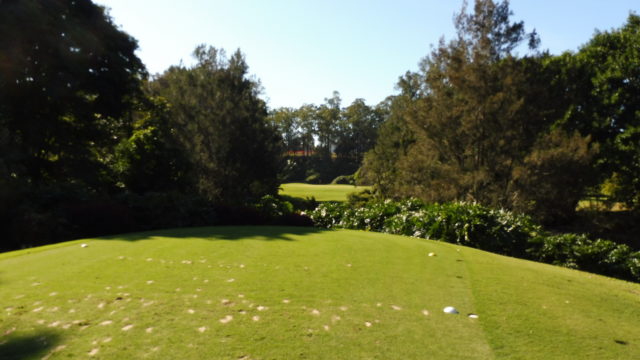
Hole 6 – 152 meter par 3
Passing the 19th hole and clubhouse on the way to the easiest par 3 on the course, although looking from the tee, this is not what is the first thoughts are on this penal designed hole. Playing through a narrow opening with the road below (unseen but heard if a car drives past), the target looks very small.

Wide 6th green
A creek is carried in the shot to the green. With heavy rain falls, this green can become unreachable (very heavy flood type situations), which brings the 19th hole into play. The landing area is more than generous, something you don’t get a feel of from the tee. The putting surface is quite wide, although not overly deep. Well designed hole, deceptive where fear can be instilled in the player, especially for first time visitors.

Hole 7 – 368 meter par 4
Playing back across the water, this medium length hole doglegs to the right, over a rise hiding the lead in to the hole. For the extremely long and brave hitters, the line can be slightly right of the bunker, but for most mere mortals, playing to the left is the ideal place. If the hill can be carried an easier shot awaits. Above is Club President Sid who was in my playing group.

Carrying the hill on the 7th fairway
Trees and water are down the right, with many mounds and hollows left. Playing down a gentle slope to a slightly raised green, the approach allows for a variety of shots, with the front being quite open. Nice hole offering variety with each shot. Also very scenic with the approach.

Hole 8 – 151 meter par 3
Playing from an extremely elevated tee, this medium length par 3, will obviously play a lot shorter than the distance suggests. This penal designed hole has water hazard must be carried to reach the green, but also staying within the narrow chute is also critical. If you think the 6th tee shot is intimidating, this once just took the cake.

Small 8th green
The green has trouble on all sides, although it is a little bit of distance to the water on the front, left and rear sides. This is truly a small target requiring an excellent tee shot to find the putting surface. Visually beautiful, but also intimidating. Probably one of the hardest tee shots I face are from high elevation, always concerned on distance calculations. It was the same again here.
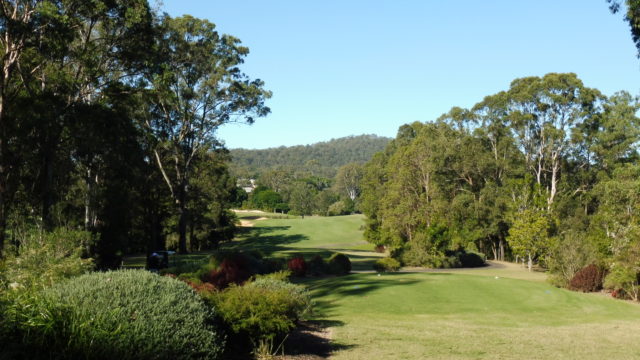
Hole 9 – 368 meter par 4
To finish the front loop is the hardest hole on the course. From the tee the ground slopes away, only to rise again at the fairway. With a small hill to carry, it is ideal to ensure you reach the top, otherwise a blind approach will be required. This fairway has a few ups and downs, but also twists and turns.

View from the 9th fairway
Reaching the summit allows an easier approach, with all of the green visible. Being too far right will require a carry across the water and also over a tree. Luckily the putting surface is quite wide, but those playing too safe carrying trouble, may find the rear bunkers. Great hole to finish the front, leaving a huge impression of this course. Hopefully this can only get better on the back.

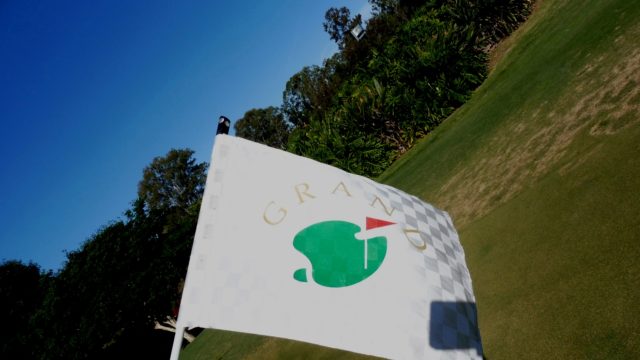
Hole marker and pin flag
The Grand Golf Club has your more traditional plates to mark hole distances. There is no map of each hole, why would there be when only members and their guests play. Each pin flag has the clubs logo, but are also different colours depending on the hole location (front, middle or back).

Hole 10 – 300 meter par 4
Feeling like I had arrived at Brookwater Golf Club (only because I had played their first, The Grand was actually built years before), play on this hole was through a narrow chute. Carrying a gully to reach the fairway, the ground rises all the way to the green.

Steep slope up the 10th fairway
Trees again are used to hide the actual width available. Fairway bunkers are in play down the right. It is only once you get to the fairway, that you realise how steep the slope is. The green itself has a large false front, in play from the fairway, but also from the rear traps.

Difficult sloping 10th green
It was here that I learnt about putting out of bunkers from one of my playing partners. Yes the lip was small, but still a bit large for my liking. The club captain informed my some of the members rack towards the lip to make an easier escape. Playing out sideways was a better option in my opinion, allowing some speed to come off the ball to avoid running through the green. So this was a nicely designed hole, with a lot of work being required around the green if you miss.

Hole 11 – 416 meter par 5
Next was the shortest par 5. Again hitting through a chute, which is narrower closer to the tee to hide part of the fairway. Bunkers are staggered before the fairway falls away.

Down a steep slope to the 11th green
This time we play down a steep slope to reach the green. The fairway also slopes greatly from the right, but has some thicker rough just off the shorter grass.

Well protected 11th green
Incorporating penal design, be warned of the forced water carry before the smallish green. Protection is found on all sides here, whether they be water or sand. The last two holes certainly show some of the large changes in elevation found along the heavier bush area. I quite liked this hole, as it allowed for a few challenges. Finding length from the tee, allows for a risky shot to reach in two, with punishment dished out if not accurate. Yes it isn’t the fairest of holes, with a forced carry, but with a short distance, allows shorter hitters to be rewarded also.

Hole 12 – 456 meter par 5
The hardest par 5, had the narrowest of all tee shots on the course. Playing the last hole through the more densely tree populate area of the routing, But again, some deception is used to hide the sides of the fairway, where slightly more room is available.

Split 12th fairway
One unusual aspect of this hole is the deviation in the fairway. It actually goes around to the right of the trees, but does leave a narrow opening for the highly risky shot to the green down the left. This is all carry over, heavy rough and a water hazard.

Looking back from the 12th green
Taking the safe option down the right doesn’t necessarily make this hole simple (you still have to navigate the trees to make it over to this section). There still could be a water carry dependent upon pin position, whilst two bunkers are in play right and rear. Certainly an interesting hole, which leaves the player many choices with the second shot. Don’t think I’ve encountered a course with so many bunkers at the rear though.
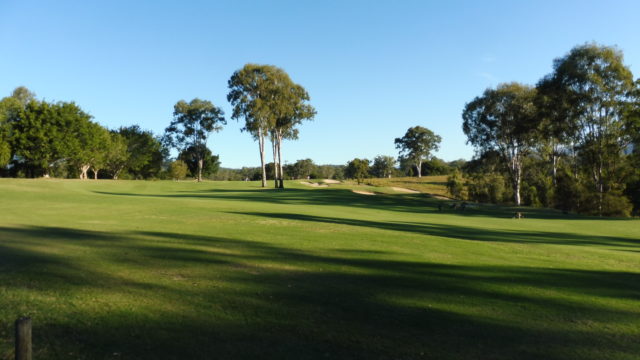
Hole 13 – 352 meter par 4
Heading out into the open areas again, the tee shot is one where you should choose wisely on where to land. With a fairway with multiple levels, falling away to the right, there are also trees to content with in the middle of the fairway. Leaving yourself directly behind these will require a low or shaped shot.

Visitors on the 13th fairway
These were not the first visitors we encountered on the journey, but they were the most vocal. A large male kangaroo (not pictured) was not happy with either us or another male in the group. Reaching the lower portion of the fairway beyond the bunker, leaves a clear shot to the green.

Looking back from the 13th green
There is a small front leading away from the green, but the ball can still be run in if required, especially if behind the fairway trees. As previously mentioned the fairways were quite firm, having gently slopes which could be tricky to contend with at times. Felt relieved playing this hole, getting over the claustrophobia of the previous three tree lines holes.

Hole 14 – 150 meter par 3
Rather an interesting having the hardest par 3 being the shortest hole on the course. Playing down hill from the tee, there is a full view of everything to contend with. The main danger is out of bounds right, or the bunkers located to the left of the green.

Heavy rough short of the 14th green
Those thinking about running the ball in are required to carry the rough, which is short of the green. The putting surface is wider than it is deep, which makes missing slightly right a good option. Interesting that this is ranked the hardest par 3, as I felt the 8th was a lot tougher. Good hole for the scenery.

Hole 15 – 285 meter par 4
The easiest hole on course is also the shortest par 4. Playing from an elevated tee, the fairway angles away, beyond a water hazard. Incorporating cape designed principles, this hole offers the player the ability to take on as much as they dare to shorten the approach.

Heavily bunkered 15th fairway
Trying to reach the green, or avoid the water, then brings in the bunkering along the back of the fairway. These are certainly in play for those taking on the challenge.

Looking back from the 15th green
Bunkers to the right partially the view of the green, making the approach slightly more difficult. Those playing long may find the water behind. The putting surface is quite long and narrow. Well designed hole, which can be played numerous ways, but fair to all levels of player.

Hole 16 – 174 meter par 3
The last of the short holes for the day, wasn’t so short, in the fact it was the longest par 3, also playing up hill. To make it slightly more difficult, the putting surface cannot be seen and bunkers must be carried to reach the green.

Shadows falling on the 16th green
This large green has some stronger sloping towards the front. Missing to the right allows more green to work with due to its width. Tougher hole due to length, especially playing up hill, but does not require high accuracy.

Hole 17 – 463 meter par 5
The penultimate hole, is the easiest par 5. Play on this dogleg left, is to a plateau, which is heavily bunkered down the left.

Rolling down the 17th fairway
Beyond the plateau, the fairway falls steeply away towards the green. It almost looks like a large slide, with various humps on either side. If not confident of carrying the water carry to the raised green, there are various levels to layup the approach.

Looking back from the 17th green
A large tree is found to the left of the green, which blocks the approach to this side, unless you are capable of a high ball flight. A solitary bunker is found at the front of the green, again with the customary bunkers rear. This green has slight tier changes to contend with. Interesting hole, especially the tree almost in the centre of the fairway. I was told there were previously multiple trees blocking the approach. Glad to see these have been reduced, to make play more enjoyable. I experienced a similar occurrence at my previous club and can think of nothing worse, than having to force the same shot week after week through a narrow opening.

Hole 18 – 347 meter par 4
Finishing the round is the second hardest hole. There is a great similarity between the 18th and the 9th. Both play over a gully before the fairway rises, before slightly turning to the left.

Approach from the 18th fairway
Being too far to the right will bring a large tree into play on the approach. Similar to the 9th water is in play to the right short of the green. The main difference is the 18th green is more elevated and the water is only in play on wayward shots.

One last look back from the 18th green
Three large traps protect the front of the green, which is quite wide but not overly deep. This was a nice hole to finish the round, with the clubhouse sitting in the background. There is multiple options available on the approach and plenty of area to layup if out of position.

Hole 19 – 138 meter par 3
One aspect I find a great addition on a course, is an extra hole. The 19th is also the shortest and easiest par 3 (when in play). This is used by the ladies, instead of the 6th, but also used by the men when the 6th is out of play due to flooding. It is quite a picture from the clubhouse with the gardens in view.

The 19th green with clubhouse behind
Playing slightly down hill, the green has bunkers covering the left and rear of the putting surface. I can’t comment too much on its design as we had to rush past due to time constraints.
In summary I have to make sure I am truly objective about the course. No doubt the whole day was absolutely fantastic, making this a first class experience. From the welcoming introductions, lunch, golf, dinner, even the small gifts. This was that much better as there was such a small group attending the open day.
Taking all that aside, the course was still great, even though it did have some nuances. The conditioning of the course was immaculate, almost perfect, from tee to green. Putting surfaces were firm, but still receptive, but the ball rolled true at all times.
Most holes offered some sort of risk or reward, with varying aspects of design utilised. Around four penal designed holes were found on the course, maybe two too many. I don’t mind the odd one, but if we take out the two par 3 holes, this doesn’t look too bad.
Looking at the course makeup:
- Hole Directions – There was a good variety allowing for conditions to have wide ranging effects during play. Basically all points of the compass are covered. There are a few consecutive holes where play is back and forth in similar direction, but not enough to be highly critical
- Hole Lengths – Par three holes had too many holes with a similar distance, three varying by two meters. To be fair one of those played from an extremely elevated tee so a different club would be required. The majority of these holes were mid length. Par four holes ranged from short to long with the majority being either short or mid length. Even though consecutive holes had similar lengths, the use of elevation change ensured that club distances changed significantly. Par 5 holes ranged from short to long with mid length being the majority. The short par 5, which is a rarity on most clubs, was enjoyable.
- Hole Layout – There was a decent mixture in how the holes played, with almost a 50/50 split on holes turning right vs left. The only critical point is three consecutive holes (10-12) all had right turns, whilst three of the last four all turned to the left.
This is certainly a course worth playing and I wouldn’t hesitate to play there again. One of the better designed courses from Norman & Harrison, where there has been some leniency with the outskirts of the fairways, not finding heavy penal rough.
I mustn’t forget to thank our playing partners Ian and Sid for making us feel so welcome, as well as assisting us to navigate our way around the course. This should actually extend to the Club Captain, as well as the GM Michelle. This was truly a memorable day.
How to play at The Grand Golf Club:
1. Be invited by a member
I played due to an open day being held by the club, from which I can see, is a rarity.

